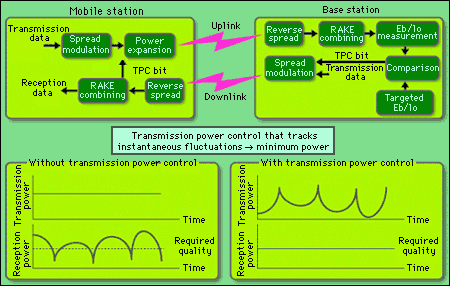W-CDMA Technology Supporting Third-Generation Mobile Communications System -6.SIR-Based Adaptive Transmission Power Control
One of the problems under CDMA is that carrier waves of the same frequency are employed for all users. This means that, when portable units transmit radio waves at the same transmission power regardless of the distance from the base station, radio waves from nearby mobile units are so strong that signals from more distant portable units cannot be separated.
In order to resolve this so-called "near/far problem," adaptive transmission power control in which each portable terminal reduces its transmission power to the required minimum becomes essential. Adaptive transmission power control is also effective in suppressing interference to low levels, thereby contributing to increasing the subscriber capacity of the system.
In the W-CDMA system, adaptive transmission power control is based on the signal-to-interference ratio, or SIR measurement value. SIR is measured by the RAKE synthesis of inverse-spread signals at the base station, and a command is issued to the portable unit to reduce the transmission power whenever the measurement value is larger than the target value. In the opposite case, a command to increase the transmission power is issued. The portable terminals receiving such commands control transmission power accordingly. By realizing this operation at the extremely high speed of once every 0.625 ms, transmission-side power control can eliminate fading-induced fluctuations in the reception level and also make it possible to minimize transmission power.

![]() Created 1999/03
Created 1999/03
